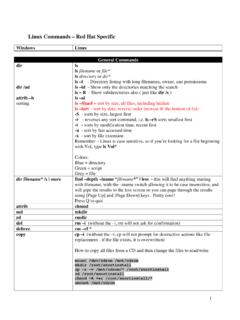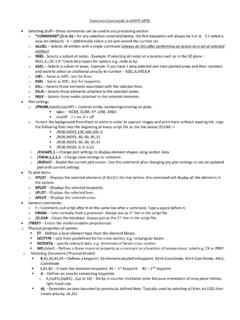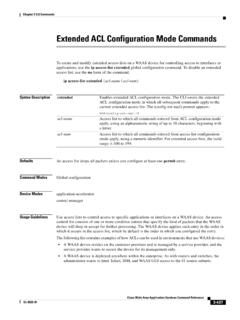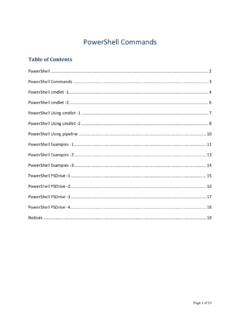Transcription of Cisco Commands Cheat Sheet - netwrix.com
1 Cisco Commands Cheat Sheet2 COMMANDPURPOSE enableconfigure terminalreloadip address ip-address maskip default-gateway ip-addressshow running-configdescription name-stringinterface fastethernet/numbercopy from-location to-locationcopy running-config startup-configcopy startup-config running-config write eraseerase startup-configshutdownno shutdownhostname nameLogs you into configuration modeAn exec mode command that reboots a Cisco switch or routerAssigns an IP address and a subnet maskSets the default gateway on a Cisco deviceAn enable mode command that displays the current configurationA config interface command to describe or name an interfaceEnters interface configuration mode for the specified fast ethernet interfaceAn enable mode command that copies files from one file location to anotherAn enable mode command that saves the active config, replacing the startup config when a Cisco network device initializesAn enable mode command that merges the startup config with the currently active config in RAMAn enable mode command that deletes the startup configUsed in interface configuration mode.
2 Shutdown shuts down the interface, while no shutdown brings up the interfaceSets a host name to the current Cisco network deviceLogs you into enable mode, which is also known as user exec mode or privileged modeBASIC CONFIGURATION Commands show running-config interface interface slot/numberip name-server serverip-1 serverip-2show ip interface [type number]An enable mode command to display the running configuration for a specific interfaceDisplays the usability status of interfaces that are configured for IPA configure mode command that sets the IP addresses of DNSservers3ping {hostname | system-address} [source source-address]speed {10 | 100 | 1000 | auto}cdp runno cdp runduplex {auto | full | half}show cdpshow cdp neighbors [detail]show interfacesshow mac address-tableAn interface mode command that manually sets the speed to the specified value or negotiates it automaticallyA configuration mode command that enables or disables Cisco Discovery Protocol (CDP) for the deviceAn interface mode command that manually sets duplex to half, full or autoShows whether CDP is enabled globallyLists summary information about each neighbor connected to this device.
3 The detail option lists detailed information about each neighborDisplays detailed information about interface status, settings and countersDisplays the MAC address tableUsed in enable mode to diagnose basic network connectivityshow interface statusshow vtp statusshow interfaces trunkshow vlanshow vlan briefshow interfaces switchportDisplays the interface line statusLists information about the currently operational trunks and the VLANs supported by those trunksLists each VLAN and all interfaces assigned to that VLAN but does not include trunksLists the current VTP status, including the current modeDisplays a large variety of configuration settings and current operational status, including VLAN trunking detailsTROUBLESHOOTING COMMANDS4ip route network-number network-mask {ip-address | interface}router ripversion 2network ip-addresspassive-interface interfaceno auto-summaryEnables a Routing Information Protocol (RIP) routing process, which places you in router configuration modeIn router configuration mode, disables automatic summarizationIn router configuration mode, associates a network with a RIP routing processIn router configuration mode, sets only that interface to passive RIP mode.
4 In passive RIP mode, RIP routing updates are accepted by, but not sent out of, the specified interfaceIn router configuration mode, disables automatic summarizationSets a static route in the IP routing tableshow ip rip databaseswitchport access vlanswitchport trunk encapsulation dot1qswitchport accessvlanip nat inside source {list{access-list-number | access-list-name}} interface type number[overload]ip nat inside source static local-ip global-ipip nat [inside | outside]Displays the contents of the RIP routing databaseSets the VLAN that the interface belongs toSpecifies encapsulation on the trunk linkCreates a VLAN and enters VLAN configuration mode for further definitionsA configuration mode command to establish dynamic source translation. Use of the list keyword enables you to use an ACL to identify the traffic that will be subject to NAT.
5 The overload option enables the router to use one global address for many local configuration mode command to establish a static translation between an inside local address and an inside global addressAn interface configuration mode command to designate that traffic originating from or destined for the interface is subject to NATA ssigns this port to a VLANROUTING AND VLAN COMMANDS5encapsulation dot1q vlan-idswitchport trunk {encapsulation { dot1q }vlan vlan-id [name vlan-name]switchport mode { access | trunk }A configuration mode command that defines the matching criteria to map frames ingress on an interface to the appropriate service instanceSets the trunk characteristics when the interface is in trunking mode. In this mode, the switch supports simultaneous tagged and untagged traffic on a portConfigures the VLAN membership mode of a port.}
6 The access port is set to access unconditionally and operates as a non-trunking, single VLAN interface that sends and receives non-encapsulated (non-tagged) frames. An access port can be assigned to only one trunk port sends and receives encapsulated (tagged) frames that identify the VLAN of origination. A trunk is a point-to-point link between two switches or between a switch and a routerConfigures a specific VLAN name (1 to 32 characters)6ip address dhcpip dhcp pool namenetwork network-number [mask]domain-name domainip helper-address addressdefault-router address[address2 .. address8]ip dhcp excluded-address ip-address [last-ip-address]A configuration mode command to configure a DHCP address pool on a DHCP server and enter DHCP pool configuration modeUsed in DHCP pool configuration mode to configure the network number and mask for a DHCP address pool primary or secondary subnet on a Cisco IOS DHCP serverUsed in DHCP pool configuration mode to specify the domain name for a DHCP clientAn interface configuration mode command to enable forwarding of UDP broadcasts, including BOOTP.
7 Received on an interfaceUsed in DHCP pool configuration mode to specify the default router list for a DHCP clientA configuration mode command to specify IP addresses that a DHCP server should not assign to DHCP clientsA configuration mode command to acquire an IP address on an interface via DHCPDHCP COMMANDS7username name password pass-valueenable password pass-valueservice password-encryptionenable secret pass-valuecrypto key generate rsaaccess-classip access-list {standard | extended} {access-list-name | access-list-number}access-list access-list-number {deny | permit} source [source-wildcard] [log] transport input {telnet | ssh}ip domain-name nameA global command that defines one of possibly multiple user names and associated passwords used for user authentication.
8 It is used when the login local line configuration command has been usedA configuration mode command that defines the password required when using the enable commandA configuration mode command that directs the Cisco IOS software to encrypt the passwords, CHAP secrets, and similar data saved in its configuration fileA configuration mode command that sets this Cisco device password that is required for any user to enter enable modeA configuration mode command that creates and stores (in a hidden location in flash memory) the keys that are required by SSHR estricts incoming and outgoing connections between a particular vty (into a basic Cisco device) and the addresses in an access listA configuration mode command that defines a standard IP access listUsed in vty line configuration mode, defines whether Telnet or SSH access is allowed into this switch.
9 Both values can be specified in a single command to allow both Telnet and SSH access (default settings)Configures a DNS domain name password pass-valueLists the password that is required if the login command (with no other parameters) is configuredA configuration mode command that defines an IP access list by name or numberSECURITY COMMANDS8deny source [source-wildcard]ntp peer <ip-address>switchport port-security maximum maximumswitchport port-securityswitchport port-security violation {shutdown | restrict | protect}show port security [interface interface-id]switchport port-security mac-address {mac-addr | {sticky [mac-addr]}} Used in ACL configuration mode to set conditions in a named IP ACL that will deny packets. To remove a deny condition from an ACL, use the no form of this commandUsed in global configuration mode to configure the software clock to synchronize a peer or to be synchronized by a peerUsed in interface configuration mode to set the maximum number of secure MAC addresses on the portUsed in interface configuration mode to enable port security on the interfaceUsed in interface configuration mode to set the action to be taken when a security violation is detectedDisplays information about security options configured on the interfaceUsed in interface configuration mode to add a MAC address to the list of secure MAC addresses.
10 The sticky option configures the MAC addresses as sticky on the interfacepermit source [source-wildcard] Used in ACL configuration mode to set conditions to allow a packet to pass a named IP ACL. To remove a permit condition from an ACL, use the no form of this command9logging trap levelshow loggingswitchport port-security maximum maximumterminal monitorUsed in configuration mode to limit messages that are logged to the syslog servers based on severity. Specify the number or name of the desired severity level at which messages should be loggedEnable mode command that displays the state of system logging (syslog) and the contents of the standard system logging bufferAn enable mode command that tells Cisco IOS to send a copy of all syslog messages, including debug messages, to the Telnet or SSH user who issues this commandUsed in interface configuration mode to enable port security on the interfacelogging ip addressConfigures the IP address of the host that will receive the system logging (syslog)

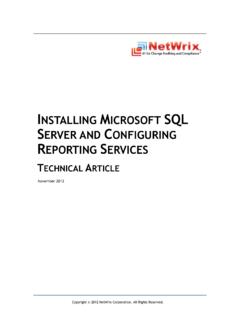
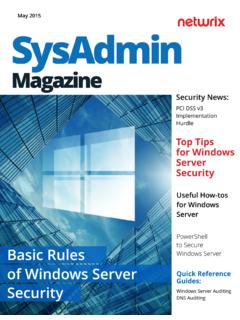




![Unix Commands [pdf] - Carnegie Mellon University](/cache/preview/1/9/d/8/8/7/a/6/thumb-19d887a6549337a2512a4a299b61c163.jpg)

